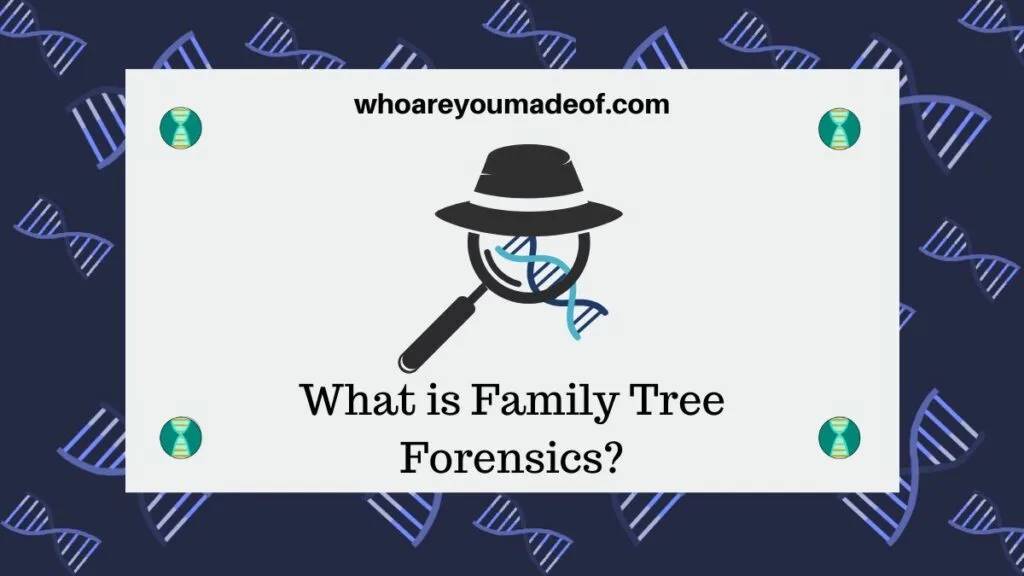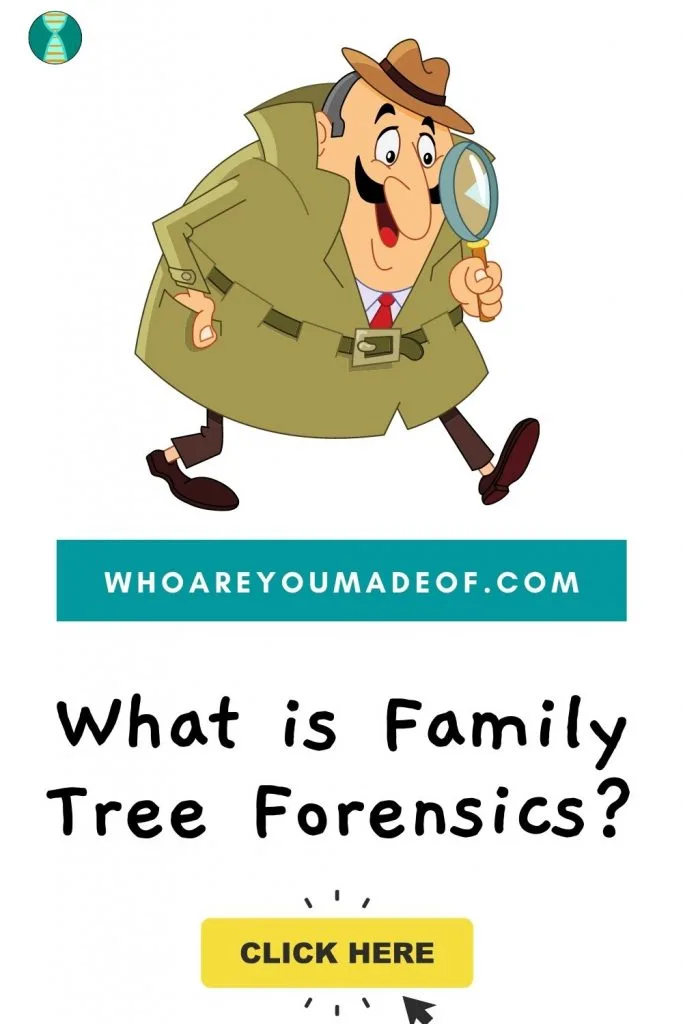Have you heard the mention of family tree forensics in the news? Are you curious about the process used to use DNA and family tree information to track down criminals?
You have come to the right place to get answers to your questions about how law enforcement is able to use family tree information and DNA match lists to solve even the coldest of cases.

In this post, I'll explain:
- What family tree forensics actually is
- How family tree forensics works
- How you can can help the process of family tree forensics move forward?
What is family tree forensics?
Family tree forensics is the use of DNA and family tree data to learn the identify of criminals. All that is needed is a file containing sequenced genetic information obtained from a DNA sample belonging to the criminal and an experienced genealogist who understands how DNA is inherited.
Just like when you and I take a DNA test or upload our sequenced DNA data to various websites, specialized researchers can upload sequenced data from criminals into the same databases that we use. This process allows us (and now, we understand, law enforcement) to have access to a DNA match list - in other words, people who are genetic relatives to the alleged criminal.
Experienced genetic genealogists can use DNA data from relatives of criminals in order to identify the family of the criminal. Law enforcement agencies can then employ traditional investigative methods to eliminate potential suspects once the immediate family of the criminal has been identified.
I'll discuss a little more about the basics how this fascinating process works below.
How does family tree forensics work?
Once someone investigating a case has obtained the file with DNA information belonging to the criminal and has uploaded it to a database, they will be able to request a list of DNA matches from the online database. Depending on how many genetic relatives the criminal has in the database, this list could contain many thousands of names.
To catch a criminal, a DNA match list is key
The most important aspect of finding the identity of a criminal with DNA is the list of genetic relatives, or the DNA match list. This is a list of the people who share DNA with either the criminal or the victim, in the case of law enforcement trying to identify Jane or John Does.
It should be noted that the DNA match list does not allow the researcher access to the actual DNA of the DNA matches. Instead, the researcher will only be able to see how much genetic material the DNA match shares with the criminal, the location of shared DNA segments on the chromosomes, and if available, family tree information.
The idea is that a genetic genealogist, a person who is experienced with using DNA for genealogy, would be able to piece together a partial family tree for the criminal, or suspected criminal, depending on the circumstance.
For example, let's pretend that my third cousin on my dad's side of the family had committed a terrible crime. I don't know this third cousin; he's a stranger to me.
To be clear, I actually don't know many of my third cousins since the average person might have as many as 200 third cousins. You probably don't know many of your third cousins personally, either.
Let's also say that this third cousin left some of his DNA at the crime scene (yikes!) and law enforcement decided to pursue this family tree forensics avenue to discover his identity. In our imaginary scenario, they uploaded his DNA data to a popular website for researching one's family tree using DNA analysis.
Of course, since my DNA data is in the same database, I will show up as a DNA match. Since the criminal and I share several third cousins in common and a few of them have done DNA tests, these individuals will also show up on the criminal's DNA match list.
Family tree forensics requires a lot of research - all descendants must be traced
Using family tree data from me and our other third-cousins-in-common, the expert genetic genealogist is able to figure out which great-great grandparents our group of cousins share in common. They will then identify every single descendant of that pair of great-great grandparents.
Perhaps they learn that this particular set of great-great grandparents (that I share with the criminal) had four kids, and each of those four children had three kids. Their grandchildren each had three kids, and their great-grandchildren had two kids.
Since all of us great-great grandchildren are living, and so are our parents and grandparents, this means that our great-great grandparents have 120 living descendants. This is a large number of people, but that's okay because there is another step in the research to complete.
Sometimes, a bit of a different strategy can be used. There might only more distant cousins that show up on the DNA match list. In this scenario, one method to identify the criminal would sort the distant matches into groups of people who are likely related to each other, build out their family trees in order to identify the person who married into the family of another group of matches.
Then, the descendants of that couple are researched and identified. If this was done in addition to the research that I mentioned above for a group of third cousins, there may be overlapping names that can be looked at more closely.
Genetic genealogists understand how centimorgans can help figure out how a criminal is related to their matches
The genealogist is able to determine, using their knowledge of how you estimate a relationship based on the number of centimorgans shared, to determine relationships, that the criminal is not descended from nine of the twelve grandchildren of the great-great grandparents.
Perhaps using an additional partial family tree built from an additional group of cousins who were DNA matches, the researcher is able to cross-reference the trees and spotted the nuclear (immediate) family from whom the criminal is descended.
Traditional law enforcement investigation techniques work hand-in-hand with genealogists to narrow down suspect
Going back to my theoretical third cousin who is a criminal, the researcher might have only identified that only 32 of the descendants of those great-great grandparents are currently living.
A detective working with the genealogist might be able to match details known about my third cousin criminal with the list of 32 living relatives in order to exclude potential suspects (i.e. age, gender, geographic location, physical incapacity, details given by witnesses, etc).
Maybe they are only left with three potential suspects, at the end of their work with the genealogist, but they can be almost positive that one of the third cousins of mine that they identified is the person who left the DNA sample at the crime scene.
We've all seen enough crime television shows to imagine the next steps in the investigation (warrants, surveillance, more DNA analysis, etc) and then the suspect is, hopefully, apprehended before they can commit another serious crime. It is important to understand that all of these events take place before anyone is charged with a crime, or even arrested.
Genealogists are not single-handedly solving crimes in these cases, but their research is helping detectives and other law enforcement professionals eliminate or identify potential suspects. Then, law enforcement uses their existing procedures to continue their investigation after a potential suspect is identified.
Important: It should be noted that none of the DNA testing companies work on behalf of law enforcement or allow them access to their database in an official capacity. They have the same access that the average person does.
Is there a way you can help investigators using family trees to solve crimes?
I know that many people might have serious concerns about the idea of law enforcement scrolling through DNA match lists and researching their family trees in order to discover the identity of a criminal. Many others might find this type of investigation very exciting and want to make sure that their family tree information and DNA data is available to help law enforcement identify and apprehend dangerous criminals.
If you are interested in learning what you can do to help investigators by adding your DNA and family tree information to databases, you could consider following these steps:
- Do a DNA test (see my post about my Ultimate DNA Testing Strategy)
- Download your DNA file and upload it to some of the sites I mention here in this post: Free Sites to Upload Your DNA
- Make sure that you build an accurate family tree and that you connect it with your DNA test profile on all of the sites where you have your DNA information.
Hopefully none of our relatives are criminals! You will likely never know whether your DNA information helped catch a criminal, but it's fascinating to imagine that it might be!

Conclusion
I hope that this post gave you the information that you need to understand what people mean when they say "family tree forensics", how it works, and how you can get involved (if that's your thing ;). Now that you know a little bit about it, how do you feel about the idea of law enforcement using our family tree information combined with information about how we are related to potential criminals?
I'd love to hear from you in the comments? All respectfully expressed views are welcome!


Daniel
Monday 19th of June 2023
Whilst DNA testing may be used to solve particularly serious crimes and help protect society it may also be abused by companies, in particular insurance companies to decline individuals with particular conditions from obtaining health/life insurance. As technology progresses there may be other abuses against individuals as a result of access to DNA databases. Safeguards are often identified after the event and may be unable to prevent misuse. Just what safeguards are required to protect individuals from open access to their personal data is unclear and needs much more open discussion particularly with fast moving technology. As an extreme example individuals with particular genes may be prevented from bearing children. It will be governments that will decide what lawful access can be given to DNA databases but governments can be lobbied /influenced and representatives bought. Much more discussion and open debate is needed in this area to protect individuals.